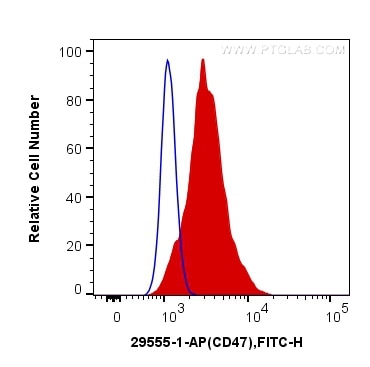CD47 Polyclonal antibody
CD47 Polyclonal Antibody for FC, ELISA
Host / Isotype
Rabbit / IgG
Reactivity
Human
Applications
FC, ELISA
Conjugate
Unconjugated
Cat no : 29555-1-AP
Synonyms
Validation Data Gallery
Tested Applications
| Positive FC detected in | HUVEC cells |
Recommended dilution
| Application | Dilution |
|---|---|
| Flow Cytometry (FC) | FC : 0.20 ug per 10^6 cells in a 100 µl suspension |
| Sample-dependent, check data in validation data gallery | |
Product Information
29555-1-AP targets CD47 in FC, ELISA applications and shows reactivity with Human samples.
| Tested Reactivity | Human |
| Host / Isotype | Rabbit / IgG |
| Class | Polyclonal |
| Type | Antibody |
| Immunogen | fusion protein 相同性解析による交差性が予測される生物種 |
| Full Name | CD47 molecule |
| Calculated molecular weight | 323 aa, 35 kDa |
| GenBank accession number | BC010016 |
| Gene symbol | CD47 |
| Gene ID (NCBI) | 961 |
| RRID | AB_2918325 |
| Conjugate | Unconjugated |
| Form | Liquid |
| Purification Method | Antigen affinity purification |
| Storage Buffer | PBS with 0.02% sodium azide and 50% glycerol pH 7.3. |
| Storage Conditions | Store at -20°C. Aliquoting is unnecessary for -20oC storage. |
Background Information
CD47, also known as integrin-associated protein (IAP), is a member of the immunoglobulin superfamily containing a five-pass transmembrane attachment. CD47 is heavily glycosylated and widely expressed by hematopoietic and nonhematopoietic cells. CD47 interacts with several membrane integrins and also acts a receptor for thrombospondin (THBS1). It is involved in a range of cellular processes, including apoptosis, proliferation, adhesion, and migration. CD47 also functions as a ligand for signal regulatory protein-α (SIRPα). Upon binding CD47, SIRPα initiates a signaling cascade that results in the inhibition of phagocytosis.
Protocols
| Product Specific Protocols | |
|---|---|
| FC protocol for CD47 antibody 29555-1-AP | Download protocol |
| Standard Protocols | |
|---|---|
| Click here to view our Standard Protocols |


